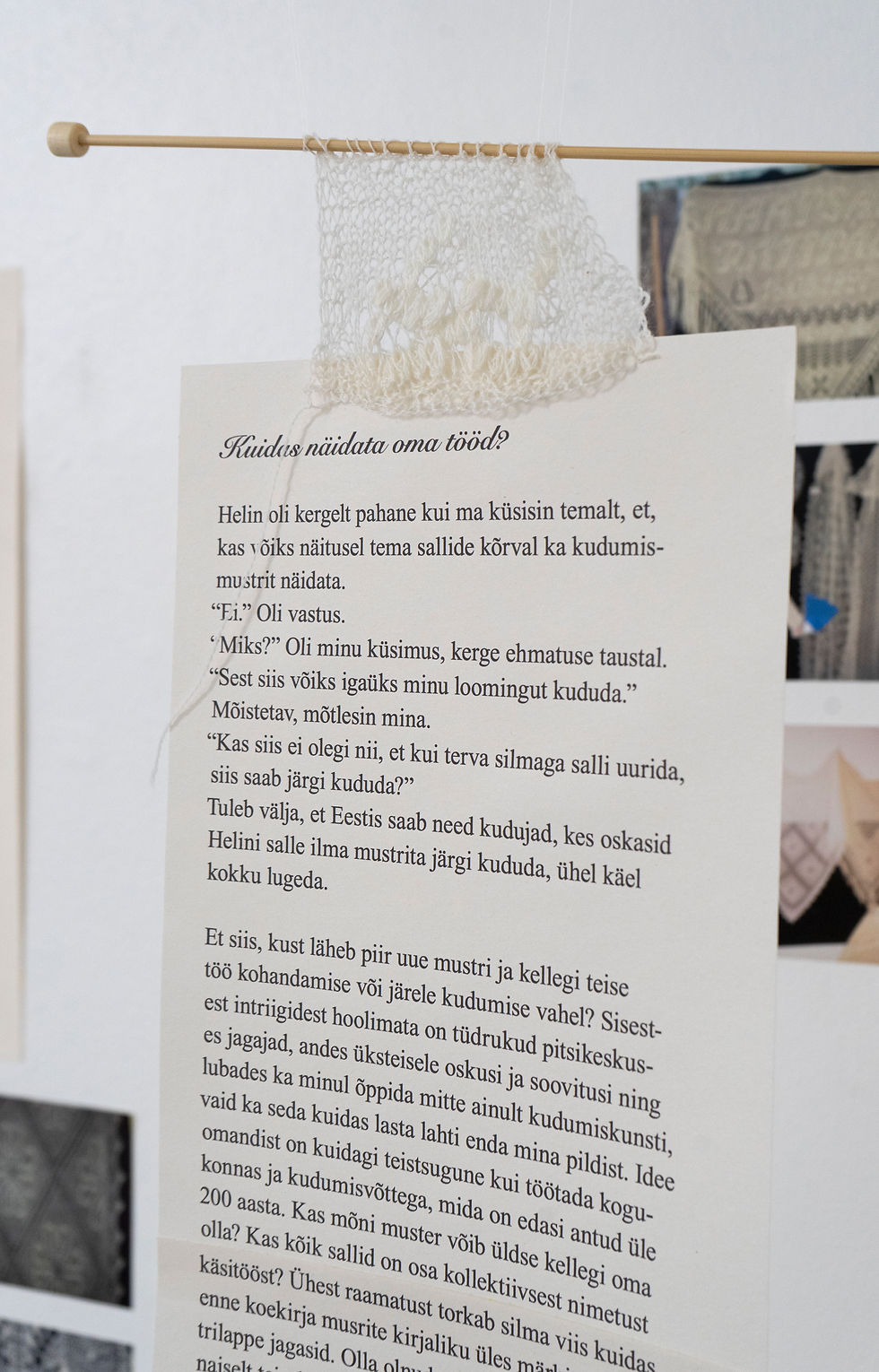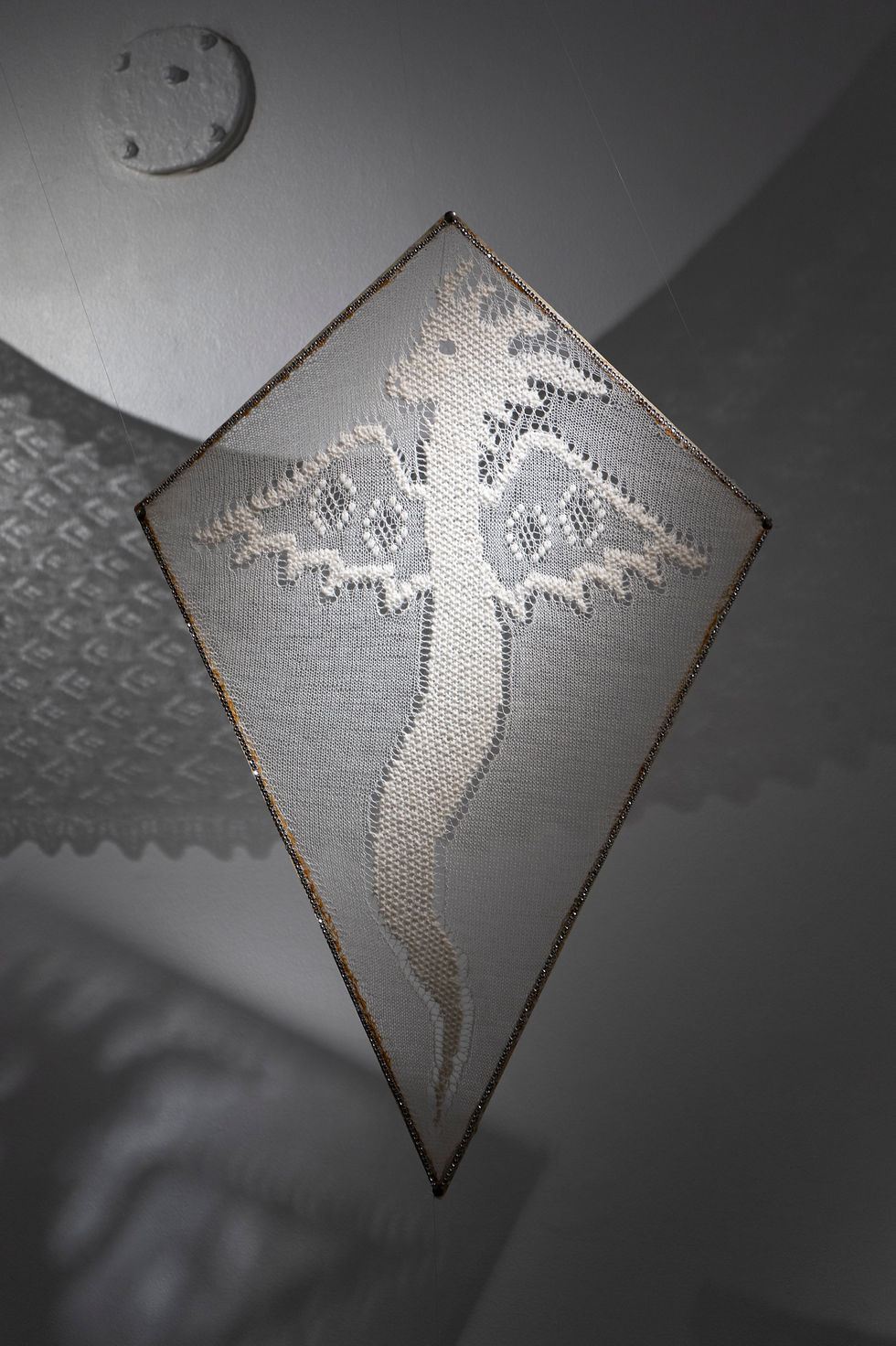It Never Gets Old(ENG) /Iial Ei Vanane (EST)
✦Haapsalu lace, originating from Haapsalu, Estonia circa 200 years ago, is renowned for its intricate, delicate designs and exceptional craftsmanship. These shawls, often crafted from fine wool, feature patterns with motifs inspired by local flora and traditional Estonian symbols. Known for their lightweight, airy texture and complex needlework, Haapsalu shawls have become culturally significant as symbols of Estonian heritage and craftsmanship. Historically, they were highly valued both locally and as tourist souvenirs, embodying a blend of artistic skill and cultural pride. Their continued relevance reflects their status as cherished artifacts of Estonian folk art and community traditions.
✧After extensive research into international lace archives, Delphine has incorporated a wide variety of lace styles and techniques from across the world into her work. Her adaptations no longer adhere to just one type of lace, reflecting a broad spectrum of methods and traditions.
7th August — 1st September 2024
at Hobusepea Galerii, Tallinn
(ENG)
Artists: Mia Tamme & Delphine Lejeune
Curator: Tiiu Meiner
"It Never Gets Old" brings together artist Mia Tamme (EST) and designer Delphine Lejeune (BE) to explore the intersection of gender dynamics, socio-economic realities, and aesthetics in lace crafts. By juxtaposing traditional techniques with innovative approaches, the exhibition encourages fresh perspectives on the relationship between craft, community, and contemporary life. It invites visitors to reconsider the role of lace in reflecting social change and the evolving nature of craftsmanship.
Mia Tamme investigates the legacy of Haapsalu lace✦ through videos, narrative reconstructions, and historical elements. Her work highlights the tensions between preserving communal traditions and adapting to contemporary changes. Focusing on the historical importance of this craft, Mia addresses the challenges of maintaining traditional practices today.
By spending time with the Haapsalu knitting collective, Mia reveals that Haapsalu lace was integral to the cultural and socio-political fabric of the area. The craft built close-knit communities and gave women opportunities and purpose. The interviews and textiles she gathers reveal that lace shawls, cherished both as cultural artifacts and tourist commodities, serve as key touchstones for understanding women's labor, rights, and creativity. Her immersion in the archives and the community exposes a significant void in historical records, a consequence of gender biases that left much of these women’s achievements undocumented. Interpreting these clues, Mia uses creative writing to fill the gaps in history and imagine less discriminatory realities.
Delphine Lejeune explores the relationship between women and machinery in the textile industry, particularly focusing on lace-making✧. Historically, this craft has been intertwined with women’s labor and artistry, yet since the early 20th century, it has faced challenges from rapid advancements in industrial technology and evolving gender roles.
Delphine reimagines the delicate beauty of lace using contemporary technologies such as 3D printing and laser etching. These modern techniques not only pay homage to meticulous craftsmanship but also comment on the evolving role of women in the textile industry. Her work reflects on how machinery has both empowered and constrained women's contributions, highlighting the complex dynamics between tradition and technological progress.
Delphine’s works feature portraits of native flower species, crafted to evoke the timeless nature of portraiture as a medium of remembrance. Each floral portrait encapsulates the essence of these species through intricate patterns that mimic traditional lace designs. This approach invites viewers to reflect on the ancient connection between nature and craftsmanship.
Public Programme:
Craft is a social and skill-based activity. Reflecting this, the exhibition will be dynamic and evolving. On August 9th at 16:00, Kaidi-Kätlin Reimann will lead a Haapsalu Lace knitting workshop for all skill levels. At 18:00, Mia Tamme will give a lecture on the lace narratives lost in time and conversation. These events underscore that craft is a living, changing practice, emphasizing its ever-evolving nature.
(Text in Estonian available on request / Eesti keelne tekst saadaval nõudmisel)


All images taken by Anna-Mari Liivrand, unless stated otherwise

Artist works depicted: Delphine Lejeune

Artist works depicted: Delphine Lejeune

Artist works depicted: Delphine Lejeune

Artist works depicted: Delphine Lejeune

Artist works depicted: Delphine Lejeune

Artist works depicted: Delphine Lejeune

Artist works depicted: Delphine Lejeune

Artist works depicted: Mia Tamme

Artist works depicted: Mia Tamme

Artist works depicted: Mia Tamme

Artist works depicted: Mia Tamme

Artist works depicted: Mia Tamme

Artist works depicted: Unknown lace maker, found by Mia Tamme
Lace Knitting Workshop by Haapsalu Lace expert Kaidi-Kätlin Reimann

Images & video from various authors
Learning to knit Haapsalu Lace

Haapsalu Lace shawl knitting materials

Kaidi-Kätlin Reimann showcasing her original Haapsalu lace scarf design
Reading & Artistic Lecture by Mia Tamme
Images from various authors

Mia Tamme's performative reading on opening night

Mia Tamme's Haapsalu knit phone

Mia Tamme giving artistic lecture about the Haapsalu lace community

Mia Tamme's archival research into the women who knit Haapsalu lace
This project was 'Funded by the European Union' and the Goethe-Institut.
Disclaimer: This work was produced with the financial assistance of the European Union. The views expressed herein can in no way be taken to reflect the official opinion of the European Union.
